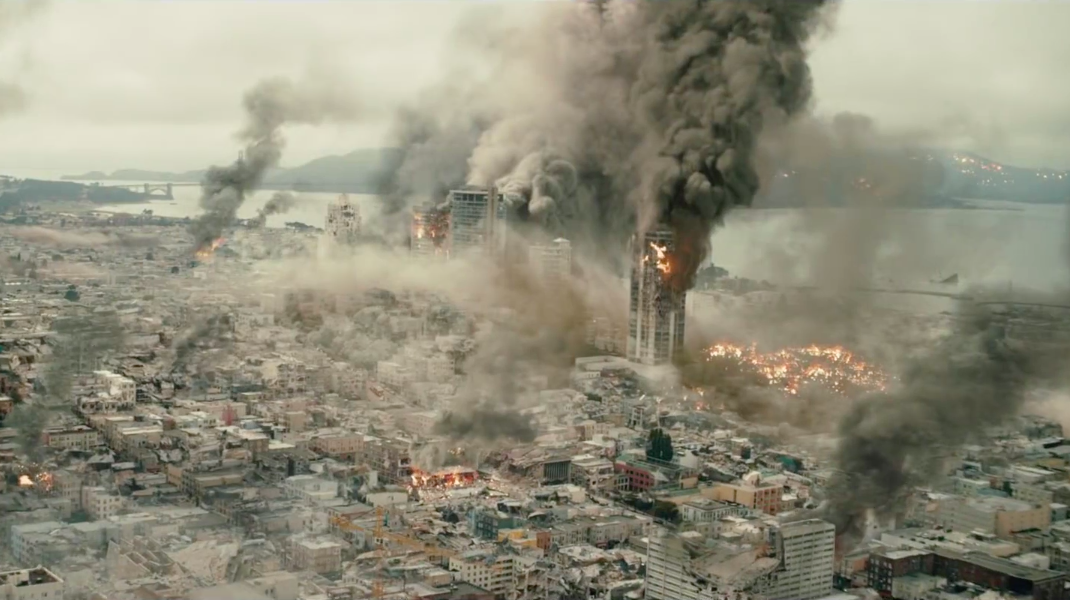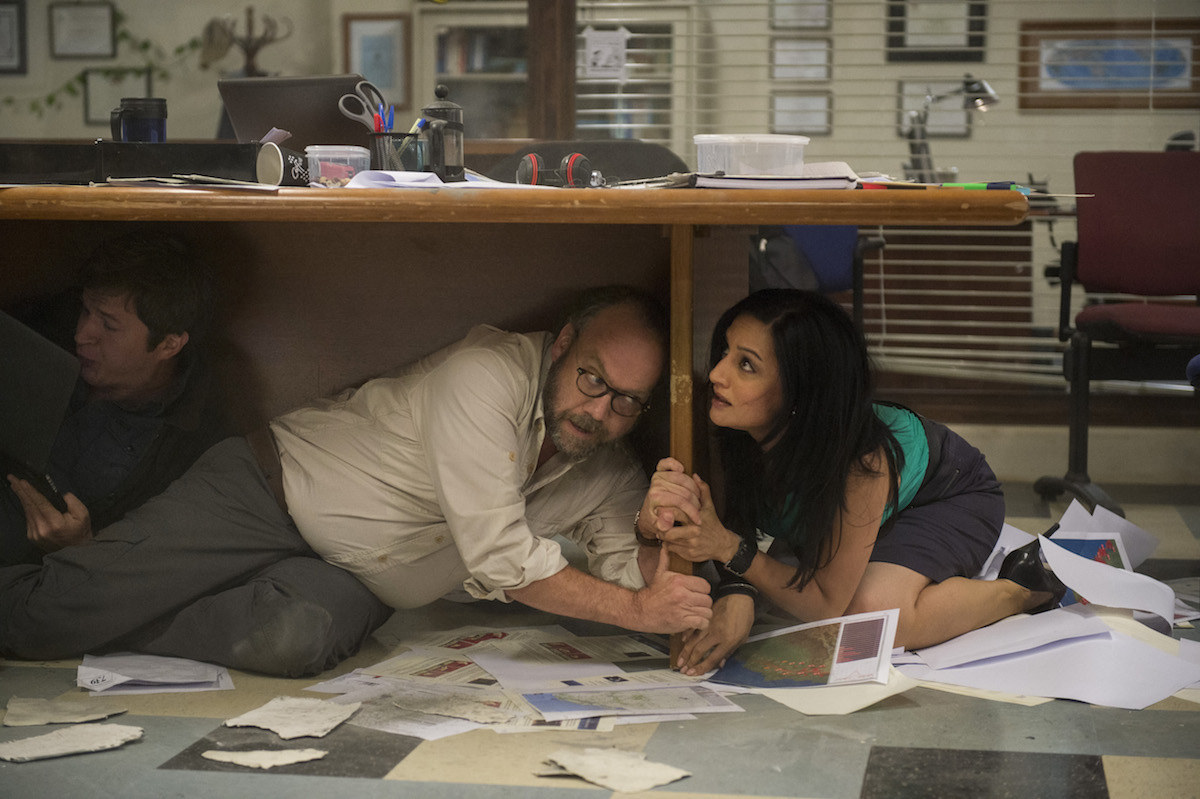
Hollywood has been in the mass disaster business since at least the Irwin Allen movies of the 1970s, and the genre’s fixation on capturing massive devastation has even earned it the nickname “disaster porn.” But San Andreas, directed by Brad Peyton (Journey 2: The Mysterious Island), represents a new benchmark in destructive realism. It purports to depict what would happen to Los Angeles and San Francisco if the titular California fault line cracked the state asunder in the biggest earthquakes in recorded history. Below, BuzzFeed Senior Film Reporter Adam B. Vary, who lives in L.A., and BuzzFeed Film Critic Alison Willmore, who grew up in the Bay Area, talk about why the film’s approach to this event left them feeling more disturbed than entertained.
Adam B. Vary: Setting aside for the moment that it’s likely impossible for the San Andreas fault line to create earthquakes of quite that magnitude, Peyton treats these seismic events straightforwardly, tasking his visual effects teams with rendering them with shuddering, rubble-strewn verisimilitude. He wants us to think, This is how this could — how it will — really happen.
Alison, as a 13-year resident of L.A. — basically my entire adult life — I’ve lived with the quiet but persistent knowledge that The Big One could hit my home at any time. And I found watching my home get pummeled during that very event as a form of popcorn-y summer entertainment to be a deeply unpleasant experience. It’s as if The Impossible, about the 2004 Indian Ocean tsunami, had opened in May with a splashy red carpet premiere and starred a sprawling cast that included Channing Tatum and a cameo by Rihanna. But I can be overly sensitive about such things. So I’m wondering, as someone who grew up in California, if you think I’m getting worked up over nothing?

Alison Willmore: I did grow up in the Bay Area, which has been pummeled on-screen recently — San Francisco is in ruins in Dawn of the Planet of the Apes and gets trampled by kaiju in Godzilla. But that’s nothing compared to what happens in San Andreas, in which San Francisco is leveled by massive earthquakes, then catches on fire, then is hit by a giant tsunami. Los Angeles takes it on the chin as well, but man, does this movie have it out for San Francisco. I was in elementary school when the 1989 Loma Prieta earthquake took place, and it definitely evokes some of the footage that looped on TV back then — especially the freeway and bridge collapses. That said, for me, this movie didn’t take much time escalating from realistic depiction of a disaster to giant, numbing CGI spectacle, so any actual quake-related fears I’ve had, most of them revolving around getting smooshed by the crumbling of whatever building I was in, faded into the background very quickly.
As you said, Adam, Hollywood has a long history of disaster movies, but what irked me about San Andreas — beyond the way it managed to make even my beloved Dwayne “The Rock” Johnson dull — is the lousy balance it maintained between its mass destruction and its relatable characters. You mentioned The Impossible, a movie that, for all its impressive filmmaking and acting, also inadvertently suggested that audiences needed a set of white characters in order to care about a Thai disaster. And I felt like San Andreas turned that into a grander screenwriting problem — in attempting to inject some smaller drama into widescale wreckage, it ends up making it feel like California was devastated and millions of people were killed in order to get the Rock’s family back together.

ABV: That disconnect is what was so disquieting to me, I think. L.A. has also certainly had its share of cinematic calamity. In 2012, the city literally cracked apart in a fantastical doomsday event; the aliens of Independence Day seemed to relish their plan to lay waste to the city (as well as to New York and Washington, D.C.); and I don’t think anyone will forget that fateful day in 2013 when a shark tornado took a bite out of Santa Monica. In all of those movies, the disasters were so outlandish — and the acting and dialogue often so enjoyably terrible — that you would be missing the point entirely if you tried to place yourself inside them. These movies are meant as engines for escapism, not empathy.
But San Andreas wants to deliver its pulpy fun with scenarios that feel genuinely plausible, like getting trapped in a car in an underground parking structure or impaled by falling glass or, yes, caught in a tsunami. The good-bad elements from other disaster movies were in ready supply — including Kylie Minogue’s blink-and-you’ll-miss-her-falling-out-of-a-building cameo — but I derived no pleasure from them. The actors played their scenes so straight, and, you’re right, the Rock’s family drama was so bland, that California’s devastation became the only thing worth paying attention to. So I just kept thinking, Yeah, something like this might actually happen to me. And when things finally did get over the top, like the Rock dodging a giant container ship as it crests over the lip of that aforementioned tsunami, it just felt that much more callous and hollow to me.
Like I said, I’m sensitive. But I’m also trying to figure out which is more frustrating: being jolted out of a silly disaster movie because the disaster feels too real, or numbly enjoying a disaster movie’s bloodless PG-13 death and expensive CG rubble because it feels too implausible to be real?

AW: It does feel to me like every other big movie ends with a city getting destroyed these days. San Andreas is a bit of a throwback in that this now happens more often in superhero battles than by way of natural disasters, but there’s a point where it all looks like the same big pile of wreckage that was artfully created on a computer somewhere. Honestly, I'm more bothered by the callousness to spectacle this has created in me than the potential exploitation of real resonance in a spectacle meant for entertainment. I remember feeling a jolt of unease the first time I saw Cloverfield and its early scenes evoking 9/11, but I think it ultimately made the movie stronger — the monster in Godzilla, after all, began as an embodiment of Japan’s fears of nuclear weapons after World War II, so why wouldn’t this creature terrorizing New York recall the terrorist attack that forever changed the city?
But the bloodlessness in San Andreas is fascinating. The movie kills off millions of people in California alone. The earth buckles, skyscrapers crumble, the ocean comes pouring into the streets. But for all the death, it’s dramatically free of dead bodies, something that really comes through in a later sequence in which characters navigate a boat across floodwaters that should be just cluttered with corpses. Instead, San Francisco looks dramatically empty, as if everyone had been neatly Left Behind–style raptured right before the wave hit, freeing the movie up to focus on its Alexandra Daddario rescue efforts. (Paul Giamatti’s professor character does issue a warning, but the fuzzy timeline doesn’t suggest nearly enough time to evacuate an entire city.) It actually made me think of Avengers: Age of Ultron, which, unlike some other recent comic book–inspired flicks, went out of its way in its own city-smashing sequence to show civilians being rescued and ushered out of danger. San Andreas doesn’t spare these people, but it does make their remains disappear. But what do you think of these halfway measures, Adam? Does the abstraction of body count in big-screen destruction like this make it more disturbing or less?
ABV: Oh, more disturbing, so much more disturbing. I mean, there’s even a disturbing thoughtlessness to this movie’s outwardly heartwarming story of a family reuniting — the Rock’s character rescues people for a living, and yet he doesn’t think twice about flying, in a rescue helicopter, over thousands of people desperately needing rescue, so he can maybe rescue his daughter in San Francisco.
You know, I think you’ve helped clarify for me why San Andreas put me into such a foul mood. It wasn’t just that it reminded me that I’m basically doomed; it was that it reminded me how fucked up it is that we treat mass death as a form of frivolous entertainment. Todd VanDerWerff at Vox recently wrote about how superhero movies over the last 15 years or so have increasingly been post-9/11 allegories. But, like you noted with Cloverfield, disaster porn movies like 2012, last year’s Godzilla remake, and San Andreas also qualify as a kind of twisted variation on the events of that day. But after surviving San Andreas, I’m not sure I will be able to find much pleasure anymore in such merciless catastrophe.

